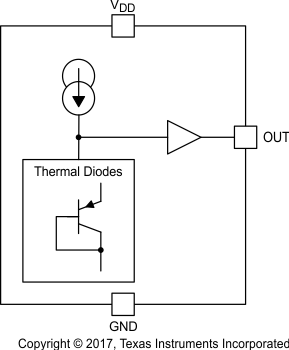TIDUCL3 February 2017
- 1 Overview
- 2 Resources
- 3 Features
- 4 Applications
- 5 Design Images
- 6 System Overview
-
7 System Design Theory
- 7.1 PCB and Form Factor
- 7.2 Optimizing Board Performance Based on LED String Voltage and Current
- 7.3 Switching Frequency
- 7.4 Output Overvoltage Protection (OVP)
- 7.5 Current Monitoring (IMON)
- 7.6 Thermal Foldback
- 7.7 Clock Generation (PWM)
- 7.8 Onboard Supply and Setting Duty Cycle
- 7.9 Buffering, Averaging, and Filtering
- 7.10 Boost Converter
- 8 Getting Started Hardware
- 9 Testing and Results
- 10Design Files
- 11Related Documentation
- 12About the Author
6.4.1 LMT87-Q1
The LMT87-Q1 is a precision CMOS integrated-circuit temperature sensor with an analog output voltage that is linearly and inversely proportional to temperature. Its features make it suitable for many general temperature sensing applications. It can operate down to a 2.7-V supply with a 5.4-μA power consumption. Package options including a through-hole TO-92 package allows the LMT87-Q1 to be mounted onboard, off-board, to a heat sink, or on multiple unique locations in the same application. A class-AB output structure gives the LMT87-Q1 a strong output source and sink current capability that can directly drive up to 1.1-nF capacitive loads. This means it is well suited to drive an analog-to-digital converter sample-and-hold input with its transient load requirements. It has accuracy specified in the operating range of −50°C to 150°C. The accuracy, three-lead package options, and other features also make the LMT87-Q1 an alternative to NTC or PTC thermistors
 Figure 2. LMT87-Q1 Functional Block Diagram
Figure 2. LMT87-Q1 Functional Block Diagram